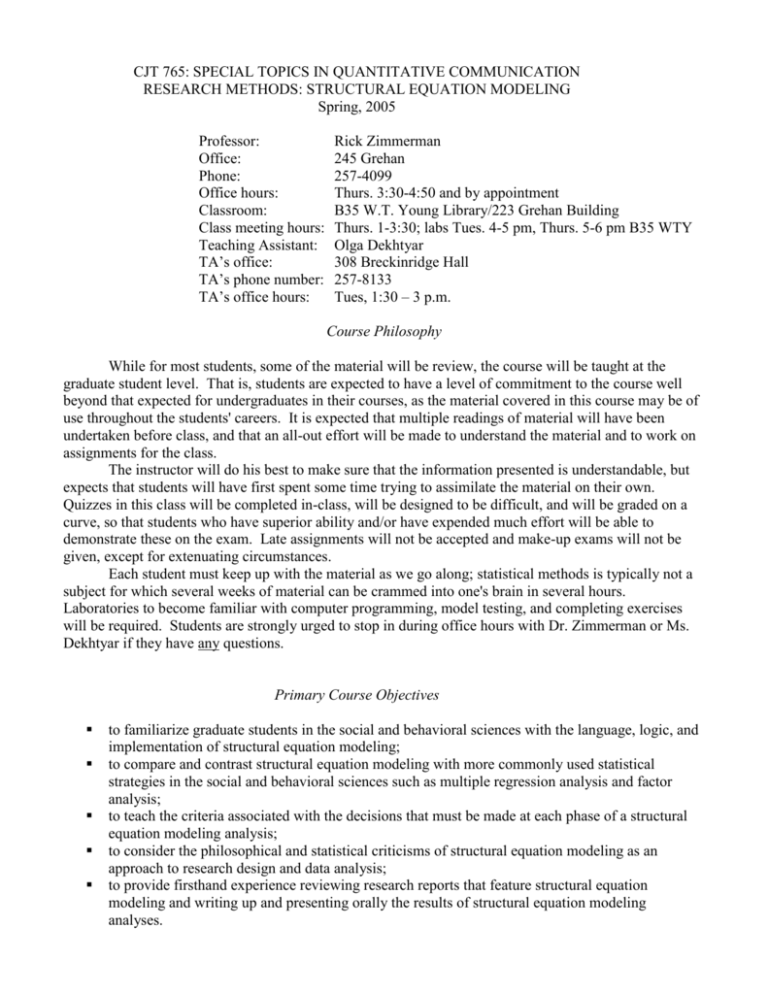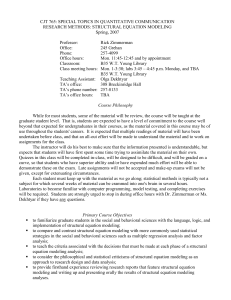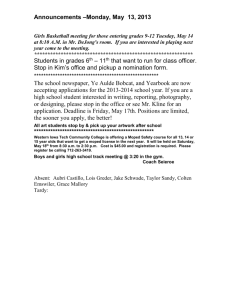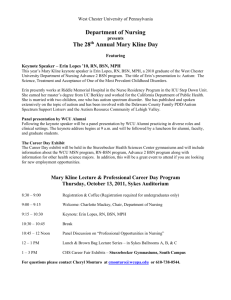cjt765 syllabus_1
advertisement

CJT 765: SPECIAL TOPICS IN QUANTITATIVE COMMUNICATION RESEARCH METHODS: STRUCTURAL EQUATION MODELING Spring, 2005 Professor: Office: Phone: Office hours: Classroom: Class meeting hours: Teaching Assistant: TA’s office: TA’s phone number: TA’s office hours: Rick Zimmerman 245 Grehan 257-4099 Thurs. 3:30-4:50 and by appointment B35 W.T. Young Library/223 Grehan Building Thurs. 1-3:30; labs Tues. 4-5 pm, Thurs. 5-6 pm B35 WTY Olga Dekhtyar 308 Breckinridge Hall 257-8133 Tues, 1:30 – 3 p.m. Course Philosophy While for most students, some of the material will be review, the course will be taught at the graduate student level. That is, students are expected to have a level of commitment to the course well beyond that expected for undergraduates in their courses, as the material covered in this course may be of use throughout the students' careers. It is expected that multiple readings of material will have been undertaken before class, and that an all-out effort will be made to understand the material and to work on assignments for the class. The instructor will do his best to make sure that the information presented is understandable, but expects that students will have first spent some time trying to assimilate the material on their own. Quizzes in this class will be completed in-class, will be designed to be difficult, and will be graded on a curve, so that students who have superior ability and/or have expended much effort will be able to demonstrate these on the exam. Late assignments will not be accepted and make-up exams will not be given, except for extenuating circumstances. Each student must keep up with the material as we go along; statistical methods is typically not a subject for which several weeks of material can be crammed into one's brain in several hours. Laboratories to become familiar with computer programming, model testing, and completing exercises will be required. Students are strongly urged to stop in during office hours with Dr. Zimmerman or Ms. Dekhtyar if they have any questions. Primary Course Objectives to familiarize graduate students in the social and behavioral sciences with the language, logic, and implementation of structural equation modeling; to compare and contrast structural equation modeling with more commonly used statistical strategies in the social and behavioral sciences such as multiple regression analysis and factor analysis; to teach the criteria associated with the decisions that must be made at each phase of a structural equation modeling analysis; to consider the philosophical and statistical criticisms of structural equation modeling as an approach to research design and data analysis; to provide firsthand experience reviewing research reports that feature structural equation modeling and writing up and presenting orally the results of structural equation modeling analyses. Elements of the Course Readings There are two required books: 1. Kline, R.B. (2005). Principles of Structural Equation Modeling (2nd edition). New York: Guilford. 2. Hoyle, R.H. (ed.) (1995). Structural Equation Modeling: Concepts, Issues, and Applications. Thousand Oaks, CA: Sage. Most weeks, additional readings are also required. More advanced topics are occasionally covered in suggested (but not required) readings, marked by an asterisk (*). All additional readings (generally as pdf files) will be posted on the course website by the first day of class. Quizzes Two quizzes will comprise the testing in the course. While we hope you will read and learn the material just for learning sake, sometimes in the mix of other activities and coursework, it is easy to let readings and mastery of the material go by the wayside. So, I think some grades related to mastery of the material may help students keep on the top of the material, and have decided to include 2 quizzes as part of your grade. Each will occupy about 30 minutes of class time on Feb. 17 and Mar. 24. Most will be short answer or short essay but some writing of computer programming, simple calculations, path diagrams, and /or interpreting output may also be included. Homework Assignments Three homework assignments will also be required. All will use the dataset we are using for the course, a 3-wave, longitudinal sample of about 3000 rural high school students from the beginning of 9th to the end of 10th grade. We will discuss the dataset and the codebook for the dataset in the first laboratory section of the course, to be held on Jan. 20 and Jan. 25. Laboratory sessions will focus on preparing students for these homework assignments, including practice questions. Research Project The major product of the course will be a written report of a structural equation modeling analysis you conduct on data of your choosing. On Feb. 10 I will ask you to specify a dataset that you will analyze and write up for the course. On Mar. 17 I will ask you to prepare a document in which you specify the names and characteristics of the variables your analysis will include and the nature of the model you plan to fit. All models should include both measurement and structural components for this assignment. About two-third of the way through the course I will ask you to meet outside of class with another member of the class to discuss your data and plan of analysis and to exchange feedback on your projects. On Apr. 14 you will provide a copy of a draft to two members of the class, and you will receive copies of two drafts from other class members. You will provide written reviews for the authors of the two drafts you receive; you will receive two reviews of your draft. On Apr. 21 your reviews will be due. The final draft of the research project is due by May 6th at 10 a.m. (the university-assigned final exam date and time). A 10-minute oral presentation will also be given on either April 21 or April 28. Attendance and Participation Students are expected to attend all class sessions, as both hearing about statistics material and reading it as important elements to learning it. Attendance is also required at laboratory sessions (1 per week), as doing statistics is probably the most important learning component of all. I also expect students’ participation in class; both the quality and quantity of student’s participation will be considered in their evaluation. A Published Article Presentation Each student will give a 5-minute presentation in which he/she describes and evaluates a published study in which the data are analyzed using structural equation modeling. Students can choose from a list of recently published articles in top-tier journals in their field of study; references and abstracts for psychology, communication, and business/economics/marketing will be available on the course website by January 31, two months before the presentations begin. Presentations will take place on March 31st and April 7th. Details about the selection of an article and the contents of the presentation will be provided around January 31st as well. Grading Three computer assignments, an oral presentation about a published article using structural equation modeling, a research project (both an oral presentation and a written paper), and a midterm exam will comprise the grading in this course. The total grade will be distributed as follows: Homework Assignments Published Article Presentation Research Project—written component Research Project—oral presentation Quizzes (2 @ 10%) Attendance/participation 24% (3 @8% each) 10% 26% 10% 20% 10% Everyone should receive an “A” or a “B” barring poor attendance or not doing the work, so that students can spend more time and energy on learning the material rather than on their grade. Course Website The website for the course is at www.uky.edu/centers/hiv/cjt765/cjt765.html. The course syllabus, assignments, dataset to be used throughout the course (in SPSS format), additional readings (in PDF files), articles for the published article presentation, datasets, and a variety of other materials will be available on the course website. Acknowledgment I would like to acknowledge the following faculty members, whose syllabi helped provide some suggestions for assignments, readings, or course organization. I either spoke to these faculty members and/or their syllabi were available through publicly accessible websites. Copies of my syllabus have been shared with them. Rick Hoyle, Duke University, Psychology/Sociology 779, Structural Equation Modeling, taught Fall, 2000 at UK. (I have especially drawn on this syllabus for readings and assignments.) Robert Hauser, University of Wisconsin, Sociology 952, Mathematical and Statistical Applications in Sociology, Topic: Path Analysis and Structural Equation Models, taught Spring, 2004. Stephen West, Cathy Cottrell, & Oi-Man Kwok, Arizona State University, Psychology 533, Structural Equation Modeling, taught Spring, 2004. Gregory Elliott, Brown University, Sociology 226, Structural Equation Models in the Social Sciences, taught Fall, 2004. Course Outline Jan. 13 Introduction to Structural Equation Modeling: Ancestry, History, and Philosophy of Science Kline: 1 Hoyle: 7 Berk (1988) Hershberger (2003) Freedman (1991a) Blalock (1991) *Wolfle (2003) Jan. 20 Review of correlation and regression Kline: 2 Cohen et al. (2003), Chapter 2 Cohen et al. (2003), Chapter 3 Jan. 27 Review of data preparation, screening, measurement issues Kline: 3 Cohen et al. (2003) pp.225-251 DeVellis (1991), pp. 1-41 Schaefer & Graham (2002) Feb . 3 Overview of SEM notation, path diagrams, programs; Homework 1 due Kline: 4; Hoyle: 1, 2, 8 Byrne (2001), Chapter 1 Byrne (2001), Chapter 2 *Byrne (1994), Chapters 1 & 2 *Kelloway (1998),Ch. 4-7 Feb. 10 Path Analysis 1: Basic theorems, mediation, coefficients, Kline: 5 pp. 93-105 Choose dataset Hoyle: 3 Kenny (1979), Chapters 3-4 Alwin (1988) Baron & Kenny (1986) MacKinnon et al. (2002) *Shrout & Bolger (2002) Feb. 17 Path Analysis 2: decomposing a correlation, direct and indirect effects, identification; Quiz 1 Kline: 5 pp. 105-122 Alwin & Hauser (1975) Holbert & Stephenson (2001) Pedhazur (1982), pp. 614-628 Fox (1980) Feb. 24 Path Analysis 3: fitting a model, fit indices, comparing models, statistical power; Homework 2 due Kline: 6; Hoyle 3, 5 Hayduk et al., (2003) Bollen & Long (1993) Tanaka (1993) *Jöreskog (1993) *Meehl & Waller (2002) *Reichardt (2002) *Dormann, 2001 *Muthén & Muthén (2002) Course Outline (cont.) Mar. 3 Measurement Models and Confirmatory Factory Analysis Kline: 7; Hoyle: 10, 12 Lance et al., 2002 Noar, 2003 Mar. 17 Putting it all together: Structural and measurement components in SEM; Turn in dataset description; Homework 3 due Kline: 8 Holbert & Stephenson (2002) McDonald & Ho (2002) Stephenson & Holbert (2003) MacCallum & Austin (2000) Hayduk & Glaser (2000) Anderson & Gerbing (1988) Bentler (2000) Bollen (2000) Mar. 24 Nonrecursive structural models; Quiz 2 Kline: 9 James & Singh, 1978 *Berry, 1984 Mar. 31 Advanced topics: Multi-group SEM, Latent Growth Models; Published article presentations 1 Kline: 10, 11 Hoyle: 11, 13 Apr. 7 Pitfalls in using SEM; Published article presentations 2 Kline: 12 Gonzalez & Griffin (2001) Apr. 14 Critique of SEM and future directions Rough draft of research report due Kline: 13 Bentler & Dudgeon (1996) McCallum et al. (1993) Raykov & Marcoulides (2001) Schumacker (2002) deJong (1999) Apr. 21 Research report presentations 1 Reviews of research reports due Apr. 28 Research report presentations 2 May 6 Research reports due, 10 a.m. Additional Readings January 13 Berk, R.A. (1988). Causal inference for sociological data. In N.J. Smelser (Ed.), Handbook of Sociology (pp. 155-172). Newbury Park: Sage. Hershberger, S. L. (2003). The growth of structural equation modeling: 1994-2001. Structural Equation Modeling, 10, 35-46. Blalock, H. M., Jr. (1991). Are there really any constructive alternatives to casual modeling? P. V. Marsden (Editor), Sociological Methodology, 21, 325-335. Cambridge, MA: Basil Blackwell. Freedman, D. A. (1991). Statistical models and shoe leather. P. Marsden (Editor), Sociological Methodology, 21, 291-313. Cambridge, MA: Basil Blackwell. January 20 Cohen, J., Cohen, P., West, S. G., & Aiken, L.S. (2003). Applied multiple regression/correlation analysis for the behavioral sciences (3rd Ed.). Hillsdale, NJ: Erlbaum. January 27 Cohen, J., Cohen, P., West, S. G., & Aiken, L.S. (2003). Applied multiple regression/correlation analysis for the behavioral sciences (3rd Ed.). Hillsdale, NJ: Erlbaum. DeVellis, R. F. (1991). Scale Development: Theory and Applications. Newbury Park, CA: Sage. Schafer, J.L., & Graham, J.W. (2002). Missing data: our view of the state of the art. Psychological Methods, 7, 147-177. February 3 Byrne, B. M. (1994). Structural Equation Modeling with EQS and EQS/Windows: Basic Concepts, Applications, and Programming. Thousand Oaks, CA: Sage. Byrne, B. M. (2001). Structural Equation Modeling with AMOS: Basic Concepts, Applications, and Programming. Mahwah, NJ: Erlbaum. Kelloway, E. K. (1998). Using LISREL for Structural Equation Modeling: A Researcher’s Guide. Thousand Oaks, CA: Sage. February 10 Kenny, D. A. (1979). Correlation and Causality. New York, NY: John Wiley. Baron, R.M., & Kenny, D.A. (1986). The moderator-mediator variable distinction in social psychological research: Conceptual, strategic, and statistical considerations. Journal of Personality and Social Psychology, 51, 173-182. MacKinnon, D. P., Lockwook, C. M., Hoffman, J. M., West, S. G., & Sheets, V. (2002). A comparison of methods to test the significance of the mediation and intervening variable effects. Psychological Methods, 7, 83-104. Alwin, 1988 *Shrout, P.E., & Bolger, N. (2002). Mediation in experimental and nonexperimental studies: New procedures and recommendations. Psychological Methods, 7, 422-445. Additional Readings (cont.) February 17 Alwin, D.F., and Hauser, R.M. (1975). The decomposition of effects in path analysis. American Sociological Review, 40, 37-47. Pedhazur, E.J. (1982). Multiple Regression in Behavioral Research, Chapter 15, pp. 577-588. New York, NY: Holt. Fox, J. (1980). Effect analysis in structural equation models. Sociological Methods and Research, 9, 3-26. Holbert, R. L., & Stephenson, M. T. (2001). The importance of indirect effects in media effects research: Testing for mediation in structural equation modeling. Journal of Broadcasting and Electronic Media, 47, 556-572. February 24 Hayduk, L., Cummings, G., Stratkotter, R., Nimmo, M., Grygoryev, K., Dosman, D., Gillespie, M., Pazderka-Robinson, H., & Boadu, K. (2003). Pearl’s D-separation: One more step into causal thinking. Structural Equation Modeling, 10, 289-311. Bollen, K.A., & Long, J.S. (1993). Introduction. In K.A. Bollen & J.S. Long (Eds.), Testing Structural Equation Models (pp.1-9). Newbury Park, CA: Sage. Tanaka, J.S. (1993). Multifaceted conceptions of fit in structural equation models. In K.A. Bollen & J.S. Long (Eds.), Testing Structural Equation Models (pp. 10-39). Newbury Park, CA: Sage *Jöreskog (1993). A review of tests within LISREL. In K. A. Bollen & J.S. Long (Eds.), Testing Structural Equation Models (pp. 130-145). Newbury Park, CA: Sage. *Meehl, P. E., & Waller, N. G. (2002). The path analysis controversy: A new statistical approach to strong appraisal of verisimilitude. Psychological Methods, 7, 283-300. *Reichardt, C. S. (2002). The priority of just-identified, recursive models. Psychological Methods, 7, 307-315. *Dormann, C. (2001). Modeling unmeasured third variables in longitudinal studies. Structural Equation Modeling, 8, 575-598. *Muthén, L. K., & Muthén, B. O. (2002). How to use a Monte Carlo study to decide on sample size and determine power. Structural Equation Modeling, 9, 599-620. March 3 Lance, C. E., & Noble, C. L. (2002). A critique of the correlated trait-correlated method and correlated Uniqueness models for multitrait-multimethod data. Psychological Methods, 7, 228-244. Noar, S. M. (2003). The role of structural equation modeling in scale development. Structural Equation Modeling, 10, 622-647. Additional Readings (cont.) March 17 Holbert, R. L., & Stephenson, M. T. (2002). Structural equation modeling in the communication sciences, 1995-2000. Human Communication Research, 28, 351-551. McDonald, R.P., & Ho, M-H. R. (2002). Principles and practice in reporting structural equation analysis. Psychological Methods, 7, 64-82. Stephenson, M. T., & Holbert, R. L. (2003). A Monte Carlo simulation of observable latent variable structural equation modeling techniques. Communication Research, 30, 332-354. MacCallum, R.C., & Austin, J.T. (2000). Applications of structural equation modeling in psychological research. Annual Review of Psychology, 51, 201-22. Anderson, J. & Gerbing, D. (1988). Structural equation modeling in practice: A review and recommended two-step procedure. Psychological Bulletin, 103, 411-423. Hayduk, L. A., & Glaser, D. N. (2000). Jiving the four-step, waltzing around factor analysis, and other serious fun. Structural Equation Modeling, 7, 1-35. Bentler, P. M. (2000). Rites, wrongs, and gold in model testing. Structural Equation Modeling, 7, 82-91. Bollen, K. A. (2000). Modeling strategies: In search of the holy grail. Structural Equation Modeling, 7, 74-81. March 24 James, L.R., and B.K. Singh. (1978). An introduction to the logic, assumption, and basic analytical procedures of two-stage least squares. Psychological Bulletin, 85, 1104-1122. Berry, W. D. (1984). Nonrecursive Causal Models. Newbury Park, CA: Sage. April 7 Gonzalez, R., & Griffin, D. (2001). Testing parameters in structural equation modeling: Every “one” matters. Psychological Methods, 6, 258-269. April 14 Bentler, P.M., & Dudgeon, P. (1996). Covariance structure analysis: Statistical practice, theory, directions. Annual Review of Psychology, 47, 563-592. MacCallum, R.C., Wegener, D.T., Uchino, B.N., & Fabrigar, L.R. (1993). The problem of equivalent models in applications of covariance structure analysis. Psychological Bulletin, 114, 185-191. Raykov, T., & Marcoulides, G. A. (2001) Can there be infinitely many models equivalent to a given Covariance structure model? Strucutral Equation Modeling, 8, 142-149. Schumacker, R. E. (2002). Latent variable interaction modeling. Structural Equation Modeling, 9, 4054. deJong, P. F. (1999). Hierarchical regression analysis in structural equation modeling. Structural Equation Modeling, 6, 187-211.








